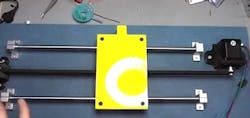Recall that a main component of a linear motion system is the linear actuator, which can be a pneumatic, hydraulic or electrical device. A good way to think of the various technologies in terms of a particular task is in the application's requirements for speed, precision and power, among other factors.
"Typically, for high-speed applications, your best bet is pneumatics," says Jerry Scherzinger, product marketing manager – pneumatics for Bimba Manufacturing. "Hydraulics suits applications such as hydraulic presses, which provide higher power and forces (1,000 to 2,000 psi supply pressure), while electric actuators are used for high-precision applications such as food packaging machinery."
High repeatability is often a critical consideration, and pneumatics can provide this when the actuator is allowed to travel to the end of its stroke, continues Scherzinger. "The actuator goes from fully retracted to fully extended, with a hard stop at each end, and it's this metal-on-metal contact, when the piston hits the end cap, that results in great repeatability," he explains. "However, because air is compressible, pneumatics fall short when the cylinder must stop mid-stroke. There are linear feedback devices such as proximity sensors that attach to pneumatic cylinders to support positioning capabilities. But pneumatics is not as accurate for a repeatable mid-stroke position as an electric actuator."
Because an electric linear actuator provides precise control of the motion profile, whether it includes two, three, 10 or 50 positions, the technology offers a flexibility not obtainable with pneumatic or hydraulic cylinders, explains Scherzinger. "A common application is using drive screw electric actuators to provide linear motion and control in conveyor systems for packaging equipment," he says. "Here, electric actuators can be used to adjust conveyor rails, adjusting the width of the conveyor for different-sized packages. Because devices like PLCs can be used for control, accommodating different types and sizes of bottles and packages is merely a matter of pre-programming the command signals required by the electric actuators This method allows users to reduce their changeover times when different-sized packages are required."
Also read: Linear Motion Moves Up and Out
Of course, components like timing belts produce linear motion, but the technology is generally not very useful in high-precision linear motion applications. "We divide the world of linear motion into power transmission applications, which use lead screws and timing belts, and motion control applications, which include high-precision, highly repeatable components in systems that are generally equipped with feedback loops," says ¬¬¬¬David Hein, vice president of engineering, Nexen Group.
System accuracy is a function of the mechanical elements that are between the load being moved and the servo motor that's driving it, continues Hein. "Development engineers can use high-precision linear encoders to mitigate mechanical inaccuracies and help smooth out backlash, but using a high-precision linear scale encoder is a costly approach." In contrast, Hein reports that because the company's mechanical components are so accurate and lack backlash, its systems can support repeatability of 3 microns, whether the mass is moved 10 m or 100 m. "Accuracy and repeatability are important in applications such as airplane assembling, where linear components position the skin of the airplane before it's attached to the frame," he says. "Exact positioning is critical so the rivets will hold the skin in the right place, a safety issue with regard to the construction of the airplane."
It’s also important to consider accuracy over distance. "As compared to ball screws and involute rack and gears, our unique technology involves the use of teeth that are physically three to four times larger in comparison and thereby provide a high torque factor or power density," adds Hein. "The technology uses rolling friction versus sliding friction so it can operate at 99% efficiency and with no lubrication when needed."
A different approach is to use a direct drive linear motor, which eliminates mechanical transmission components such as cams, rack and pinions, belts and pulleys, lead or ball screws and gears entirely while it provides high structural stiffness, high speeds and acceleration, high positional accuracy, quiet operation and smooth, error-free linear motion.
According to Aaron Eghbal, development manager at Moticont, the company recently developed a patent pending direct-drive motor with built-in encoder that has a stationary coil and a light moving magnet and shaft assembly. "Because these motors eliminate expensive transmission components such as lead or ball screws, they are more economical, more durable and more reliable with a much smaller footprint and effectively no backlash," he says.
The inherent design of this brushless actuator allows for a stationary coil that eliminates lead wire fatigue. This increases the reliability of the product and it makes it virtually maintenance-free," explains Eghbal.
The company's compact SDLM series direct-drive motors are cylindrical in shape and use an internal optical encoder that is directly mounted on the shaft assembly, providing very high accuracy ranging from sub-micron (less than 0.00004 in) to 5 microns (0.0002 in). "These compact units provide the same performance that is traditionally expected from systems which occupy much larger volumes" says Eghbal. "In some cases, these actuators can achieve speeds of up to 5 m/s and accelerations of up to about 50 g. The expected life of the product when used properly can go way beyond 100 million cycles."
About the Author
Leslie Gordon
Leslie Gordon

Leaders relevant to this article:

